Si está preocupado acerca de la actualización de su sitio web en WordPress, no está solo. Muchos principiantes nos dicen que les preocupa que una actualización pueda causar problemas a su sitio web.
Sin embargo, después de trabajar con WordPress durante tantos años, estamos convencidos de que mantener actualizado el software de su sitio web es esencial para maximizar la seguridad y el rendimiento del sitio web.
Utilizar la última versión de WordPress significa que su sitio se beneficia de las características, parches de seguridad y mejoras más recientes. Una versión obsoleta expone su sitio a riesgos y se pierde mejoras en la velocidad y funcionalidad de su sitio.
En esta guía para principiantes, le mostraremos cómo actualizar WordPress de forma segura, permitiéndole gestionar el proceso con confianza y sin miedo a causar ningún problema / conflicto / incidencia. Aprenderá a actualizar su sitio de WordPress como un profesional, garantizando al mismo tiempo que siga siendo seguro y totalmente funcional.
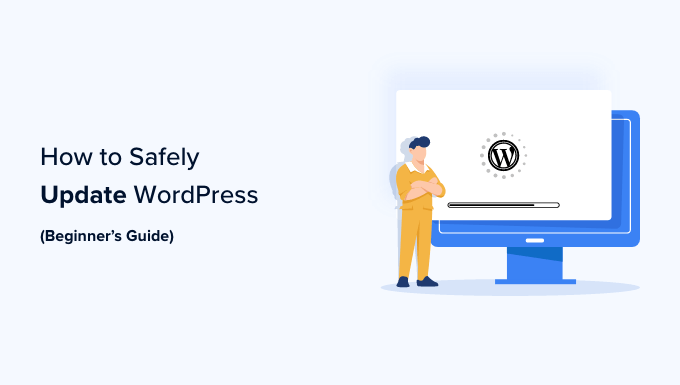
La actualización de su sitio web en WordPress es una tarea de mantenimiento periódica. Hemos creado una infografía fácil de seguir que puedes utilizar como guía de referencia.
Sólo tiene que hacer clic en la imagen inferior para ver la infografía completa, o seguir leyendo las instrucciones de texto.
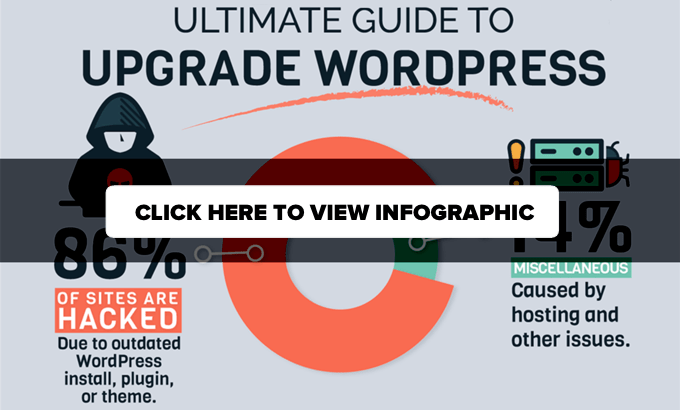
¿Por qué actualizar siempre WordPress?
Los principales estudios de seguridad de WordPress muestran que la mayoría de los sitios web de WordPress que son pirateados tienen el núcleo, los plugins o los temas de WordPress obsoletos.
El mantenimiento de WordPress corre a cargo de desarrolladores de todo el mundo. Estos desarrolladores encuentran y corrigen fallos, añaden nuevas características y detectan vulnerabilidades de seguridad con regularidad. Estos cambios se publican en una nueva versión de WordPress.
Si no se trata de una versión importante, WordPress puede actualizarse automáticamente a la nueva versión. Para versiones mayores, a menos que esté gestionando su alojamiento WordPress, tendrá que iniciar manualmente el proceso de actualización.
Necesita actualizar para asegurarse de que su sitio web tiene los últimos parches de seguridad, las características y funcionalidades más novedosas, y la mejor velocidad y rendimiento.
Puede obtener más información sobre este importante debate en nuestra guía sobre por qué debe utilizar siempre la última versión de WordPress.
Dicho esto, veamos cómo actualizar WordPress a la última versión de forma segura.
Qué hacer antes de actualizar WordPress
Lo más importante que debe hacer antes de actualizar WordPress es crear una copia de seguridad completa de WordPress.
Aunque tengas establecido un plugin de copia de seguridad de WordPress automatizado como Duplicator, debes crear una nueva copia de seguridad y almacenarla de forma segura en una ubicación remota, como tu ordenador o un almacenamiento en la nube como Google Drive.
Una copia de seguridad completa de WordPress lo incluye todo:
- Su base de datos de WordPress
- Todas tus imágenes y subidas de medios
- Tus plugins y temas de WordPress
- Sus archivos de configuración de WordPress
- Archivos del núcleo de WordPress
Este paso es crucial ya que le permitirá restaurar WordPress desde la copia de seguridad en caso de que algo vaya mal.
Una vez que haya creado una copia de seguridad completa y la haya almacenado de forma remota, podrá pasar al siguiente paso.
Actualización de WordPress a la última versión
Hay dos formas sencillas de actualizar su sitio de WordPress a la última versión. Una es automática y la otra es manual. Le mostraremos ambas.
Método 1: Actualización de WordPress mediante el sistema integrado (1 clic)
Este método es más sencillo y se recomienda a todos los usuarios.
En primer lugar, acceda al área de administrador de su sitio web de WordPress y vaya a la página Escritorio ” Actualizaciones.
Verás el aviso de que hay disponible una nueva versión de WordPress. Ahora, sólo tienes que hacer clic en el botón ‘Actualizar a la versión X.X.X’ para iniciar la actualización.
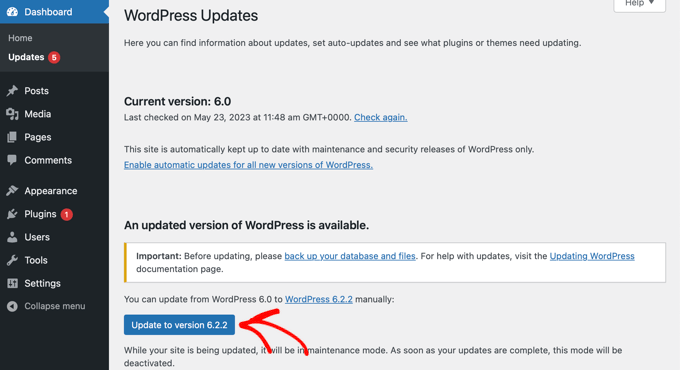
WordPress buscará la última versión del software y la instalará por usted.
Verá el progreso de la actualización en su pantalla. Durante la actualización, WordPress pondrá su sitio en modo de mantenimiento.
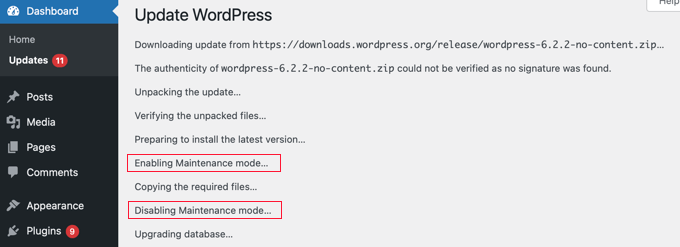
Su sitio seguirá siendo visible para los usuarios, pero no podrá instalar plugins ni temas mientras dure la actualización.
Una vez finalizada la actualización, se le redirigirá a la pantalla de bienvenida de WordPress. Dependiendo de cada versión, verás una página en la que se explican las novedades de WordPress y las características que deberías probar.
Eso es todo; ha actualizado correctamente WordPress a la última versión.
Método 2: Actualización manual de WordPress mediante FTP
Este método requiere que uses FTP para subir manualmente los archivos de WordPress. Puede utilizarlo si el primer método no funciona.
En primer lugar, tendrás que descargar la última versión de WordPress. Dirígete a la página de descargas de WordPress y haz clic en el botón “Descargar”.
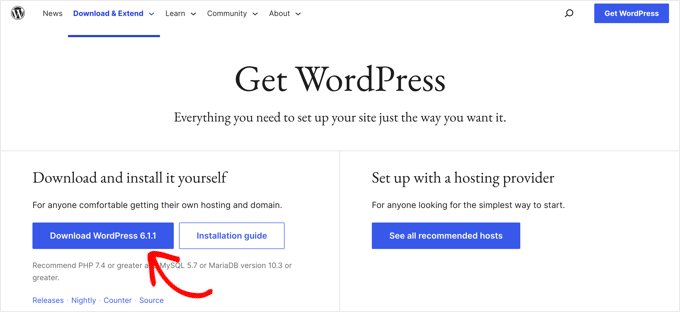
Su navegador descargará WordPress en un archivo zip. Una vez descargado, tienes que extraer el archivo zip.
Dentro, verá una carpeta wordpress. Esta carpeta contiene todos los archivos de WordPress necesarios para la actualización.
Lo siguiente que tienes que hacer es abrir tu cliente FTP y conectarte a tu sitio web. Una vez conectado, vaya a la carpeta wordpress que acaba de extraer del archivo zip en la columna de archivos locales.
En la columna de archivos remotos, vaya a la carpeta raíz de su sitio web. Esta carpeta puede ser public_html o llevar el nombre del dominio de su sitio web. Dentro de esta carpeta, verá los archivos y carpetas de WordPress.
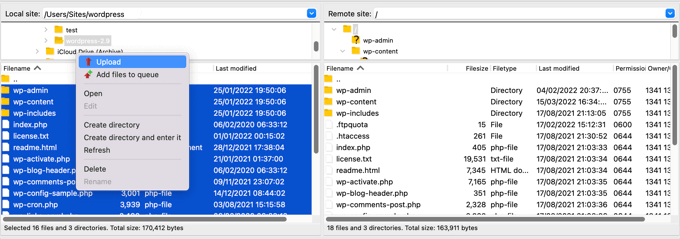
Debe seleccionar todos los archivos dentro de la carpeta de wordpress en su ordenador y luego hacer clic con el botón derecho para seleccionar ‘Subir’.
Su cliente FTP comenzará a subir los archivos de WordPress desde su ordenador a su sitio web.
Sin embargo, su sitio web ya tiene versiones anteriores de los archivos con el mismo nombre. Se le preguntará qué desea hacer con esos archivos. Debe seleccionar “Sobrescribir” y marcar / comprobar la casilla siguiente a “Utilizar siempre esta acción”.
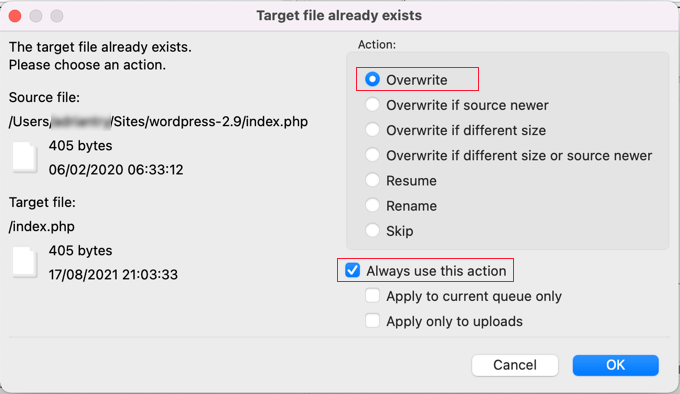
Esto garantizará que todos los archivos de WordPress de su sitio web se sustituyan por las versiones más recientes.
Una vez finalizada la subida, debe ir a su escritorio de WordPress. Este paso es necesario porque a veces, una versión más reciente de WordPress también puede necesitar actualizar su base de datos de WordPress.
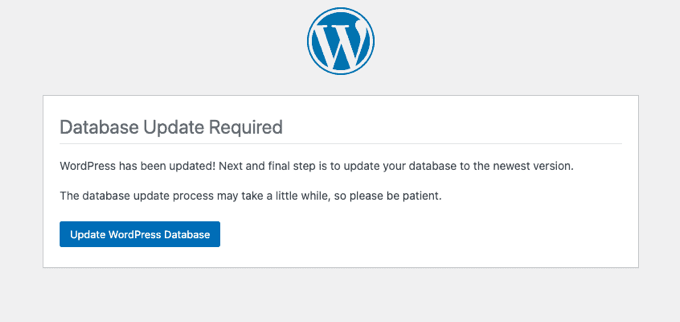
En ese caso, es posible que aparezca una página en la que se indica que es obligatorio / requerido / necesario actualizar la base de datos. Simplemente haga clic en el botón “Actualizar base de datos de WordPress” para continuar.
Eso es todo. Ha actualizado correctamente su sitio web de WordPress.
Qué hacer después de actualizar WordPress
Una vez que haya actualizado WordPress en su sitio web, debe asegurarse de que todo funciona según lo esperado. Simplemente visite su sitio web en una nueva ventana del navegador y establezca los ajustes en el área de administración de WordPress.
Si te encuentras con algún problema de compatibilidad, echa un vistazo a nuestra lista de errores comunes de WordPress y cómo corregirlos. Si el problema al que te enfrentas no aparece en el anuncio / catálogo / ficha, sigue los pasos de nuestra guía para diagnosticar problemas de WordPress para averiguar el problema y aplicar una solución.
Guías de expertos relacionadas con las actualizaciones de WordPress
Esperamos que este artículo te haya ayudado a actualizar WordPress a la última versión. Puede que también quieras ver otros tutoriales de WordPress relacionados con actualizaciones:
- Por qué debe utilizar siempre la última versión de WordPress
- ¿Debo actualizar primero WordPress o los plugins? (Orden de actualización adecuado)
- Cómo marcar / actualizar la última versión de WordPress
- Cómo comprobar las actualizaciones de seguridad de WordPress (Guía para principiantes)
- Cómo utilizar el modo de recuperación de WordPress
- Cómo gestionar mejor las actualizaciones automáticas de WordPress
- Cómo activar las actualizaciones automáticas en WordPress para las versiones principales
- Cómo desactivar las actualizaciones automáticas en WordPress
If you liked this article, then please subscribe to our YouTube Channel for WordPress video tutorials. You can also find us on Twitter and Facebook.




mohadese esmaeeli
I am a bit confused about which updating method is better, and I want to know whether to enable the automatic WordPress update feature or manually update WordPress ourselves. Alternatively, is it safer to update the WordPress core through the hosting service? Which method is more secure?
WPBeginner Support
It would depend on which you prefer using for which is best. Using a service from your hosting provider is not inherently safer unless they have a support guarantee in which case they may help you should you run into an error.
Admin
mohadese esmaeeli
Hello! In the security enhancement article that you have published, I learned that it is better to enable the automatic update feature for WordPress. However, sometimes issues arise after automatic updates. How can we prevent or troubleshoot these problems?
WPBeginner Support
For troubleshooting we do have a guide to help with general troubleshooting below, for preventing the errors that is normally done from the developer of the plugin’s side. Errors are not expected normally so if you run into one it is normally not expected.
https://www.wpbeginner.com/beginners-guide/beginners-guide-to-troubleshooting-wordpress-errors-step-by-step/
Admin
Ralph
I always keep my WordPress up-to-date. I don’t upgrade right away as I’m afraid of some bugs or errors, and I wait 3 to 5 days. I just update it in the dashboard and have never had any problems in over 10 years, but just in case, I have backups made on hosting and with a plugin.
Moinuddin waheed
This is one of the pressing issues for beginner wordpress user because it seems that updating will change everything and will affect the visual appearance of the website.
I have faced the same issue multiple times and have not updated for this reason only.
Thanks for clearing everything about updating wordpress to the latest version.
WPBeginner Support
You’re welcome and as long as there is no issues with the theme you are using, there should be no visual changes when you update your WordPress site.
Admin
Unarine Leo Netshifhefhe
Is it possible that by updating WordPress it increases chances of me being hacked? Like few hours after updating it, my website just started acting up and then was hacked,or maybe it was another reason?
WPBeginner Support
It is extremely unlikely that updating WordPress would cause your site to be more likely to be hacked. We would recommend taking a look at our guide below for steps you can take to help secure a site and prevent the other ways it could have been compromised.
https://www.wpbeginner.com/wordpress-security/
Admin
Kevin Harper
When uploading via FTP I get a “write permission denied” error for all files?
WPBeginner Support
You would likely want to check with your host’s support to ensure you have the correct permissions for your FTP user
Admin
Denis
Hi there,
One question, if we are using the FTP manual WordPress update, should we overwrite the wp-content folder of our existing site?
I am afraid it will overwrite all existing Theme, Plugins with the new WordPress wp-content default folder.
Thx for checking your instructions.
Denis
WPBeginner Support
You would copy that over as well, it should not overwrite your theme and plugins as those are not a part of the default WordPress files.
Admin
Mike
Where can I find out information on just what is included in upgrade package. Also does an upgrade include all of the websites I manage?
WPBeginner Support
Hi Mike,
WordPress updates are for the WordPress core software. Plugins and themes release their own updates.
Admin
Diana
I hate to ask the most obvious questions but the flow chart starts with “start wordpress update” where do I go in my admin section to actually find the updates? All I can find is the upgrade section which seems to be different.
WPBeginner Support
Go to WordPress admin area. In the left sidebar you will see Dashboard icon clicking on it will display Updates menu under it. WordPress will also notify you when there is a new version available for you to download and install. You can also access the update page directly by accessing the url:
http://www.example.com/wp-admin/update-core.phpDon’t forget to replace example.com with your own domain name.
Admin
Nicole
Does this only apply to wordpress.org blogs?
WPBeginner Support
yes it applies to self-hosted WordPress sites only.
Admin
Jim Walker
While upgrades are important, certainly no harm in waiting a few days.
None of the security issues are life threatening.
Never a bad idea to let others do the beta testing first… Stay frosty!
clippingimages
WoW Awesome article. Thanks for sharing this nice post.
Awesome article. Thanks for sharing this nice post.
Tina
This is a nice guide, but it’s the UPGRADE step that intimidates me! I look at the instructions on wordpress.org and I tense up, scared. Is there an easy “how to upgrade” guide anywhere for people like me?
Editorial Staff
You follow the directions in this infograph and click on Upgrade Now button in your WP-Admin panel.
Admin
Roger Duck
Updating is critical for WordPress users who want to avoid the inevitable. Hackers are searching out older versions of WordPress for the exploit vulnerabilities widely publicized. Follow this guide to lock down your WordPress site now.
Alexander
I completely agree. I keep my blog up to date, both the plugins and the WordPress built.